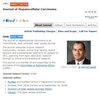基于巨噬细胞极化相关基因构建肝细胞癌预后模型
IF 4.2
3区 医学
Q2 ONCOLOGY
引用次数: 0
摘要
背景:肝细胞癌(HCC)的进展与巨噬细胞极化(MP)有关。我们的目的是确定与 HCC 患者的巨噬细胞极化相关的基因,并根据这些基因建立预后模型:我们成功建立了一个预后模型,该模型由 6 个 MP 相关基因(SCN4A、EBF3、ADGRB2、HOXD9、CLEC1B 和 MSC)组成,用于计算每位患者的风险评分。然后根据中位风险评分将患者分为高风险组和低风险组。使用 Kaplan-Meier 和 ROC 曲线评估了 MP 相关预后模型的性能,结果良好。此外,提名图还显示出良好的临床效果,并显示出与实际观察结果一致的生存预测。基因组富集分析(Gene Set Enrichment Analysis,GSEA)显示,在高风险组中,与 KRAS 信号下调、G2M 检查点和 E2F 靶点相关的通路富集。相反,与脂肪酸代谢、异生物代谢、胆汁酸代谢和脂肪生成相关的通路在低风险组中富集。风险评分与侵袭相关基因的数量呈正相关。两组患者的免疫检查点表达存在显著差异。高风险组患者对丝裂霉素C、顺铂、吉西他滨、雷帕霉素和紫杉醇的敏感性增加,而低风险组患者对多柔比星的敏感性增加。这些研究结果表明,高风险组可能有更多的侵袭性 HCC,对特定药物的敏感性更高。IHC 染色显示,HCC 组织中 SCN4A 的表达水平较高。此外,对 HepG2 细胞进行的实验表明,SCN4A 表达减少的细胞上清液可促进 M2 巨噬细胞极化标记--THP-1 细胞中的 CD163。SCN4A表达减少会诱导HCC相关基因,而SCN4A表达增加则会降低它们在HepG2细胞中的表达:由六个 MPRGs 组成的 MP 相关预后模型能有效预测 HCC 预后、推断侵袭性并指导药物治疗。SCN4A 被确定为 HCC 的抑制基因。本文章由计算机程序翻译,如有差异,请以英文原文为准。
Construction of a Prognostic Model for Hepatocellular Carcinoma Based on Macrophage Polarization-Related Genes
Background: The progression of hepatocellular carcinoma (HCC) is related to macrophage polarization (MP). Our aim was to identify genes associated with MP in HCC patients and develop a prognostic model based on these genes.
Results: We successfully developed a prognostic model consisting of six MP-related genes (SCN4A, EBF3, ADGRB2, HOXD9, CLEC1B, and MSC) to calculate the risk score for each patient. Patients were then classified into high- and low-risk groups based on their median risk score. The performance of the MP-related prognostic model was evaluated using Kaplan-Meier and ROC curves, which yielded favorable results. Additionally, the nomogram demonstrated good clinical effectiveness and displayed consistent survival predictions with actual observations. Gene Set Enrichment Analysis (GSEA) revealed enrichment of pathways related to KRAS signaling downregulation, the G2M checkpoint, and E2F targets in the high-risk group. Conversely, pathways associated with fatty acid metabolism, xenobiotic metabolism, bile acid metabolism, and adipogenesis were enriched in the low-risk group. The risk score positively correlated with the number of invasion-related genes. Immune checkpoint expression differed significantly between the two groups. Patients in the high-risk group exhibited increased sensitivity to mitomycin C, cisplatin, gemcitabine, rapamycin, and paclitaxel, while those in the low-risk group showed heightened sensitivity to doxorubicin. These findings suggest that the high-risk group may have more invasive HCC with greater susceptibility to specific drugs. IHC staining revealed higher expression levels of SCN4A in HCC tissues. Furthermore, experiments conducted on HepG2 cells demonstrated that supernatants from cells with reduced SCN4A expression promoted M2 macrophage polarization marker, CD163 in THP-1 cells. Reduced SCN4A expression induced HCC-related genes, while increased SCN4A expression reduced their expression in HepG2 cells.
Conclusion: The MP-related prognostic model comprising six MPRGs can effectively predict HCC prognosis, infer invasiveness, and guide drug therapy. SCN4A is identified as a suppressor gene in HCC.
Results: We successfully developed a prognostic model consisting of six MP-related genes (SCN4A, EBF3, ADGRB2, HOXD9, CLEC1B, and MSC) to calculate the risk score for each patient. Patients were then classified into high- and low-risk groups based on their median risk score. The performance of the MP-related prognostic model was evaluated using Kaplan-Meier and ROC curves, which yielded favorable results. Additionally, the nomogram demonstrated good clinical effectiveness and displayed consistent survival predictions with actual observations. Gene Set Enrichment Analysis (GSEA) revealed enrichment of pathways related to KRAS signaling downregulation, the G2M checkpoint, and E2F targets in the high-risk group. Conversely, pathways associated with fatty acid metabolism, xenobiotic metabolism, bile acid metabolism, and adipogenesis were enriched in the low-risk group. The risk score positively correlated with the number of invasion-related genes. Immune checkpoint expression differed significantly between the two groups. Patients in the high-risk group exhibited increased sensitivity to mitomycin C, cisplatin, gemcitabine, rapamycin, and paclitaxel, while those in the low-risk group showed heightened sensitivity to doxorubicin. These findings suggest that the high-risk group may have more invasive HCC with greater susceptibility to specific drugs. IHC staining revealed higher expression levels of SCN4A in HCC tissues. Furthermore, experiments conducted on HepG2 cells demonstrated that supernatants from cells with reduced SCN4A expression promoted M2 macrophage polarization marker, CD163 in THP-1 cells. Reduced SCN4A expression induced HCC-related genes, while increased SCN4A expression reduced their expression in HepG2 cells.
Conclusion: The MP-related prognostic model comprising six MPRGs can effectively predict HCC prognosis, infer invasiveness, and guide drug therapy. SCN4A is identified as a suppressor gene in HCC.
求助全文
通过发布文献求助,成功后即可免费获取论文全文。
去求助

 求助内容:
求助内容: 应助结果提醒方式:
应助结果提醒方式:


